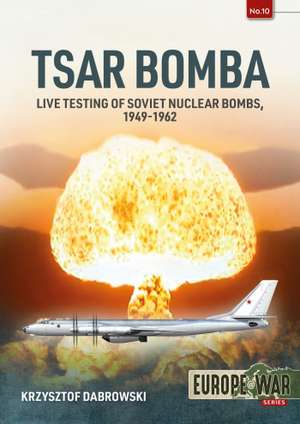Tsar Bomba: Live Testing of Soviet Nuclear Bombs, 1949-1962: Europe@War
Autor Krzysztof Dabrowskien Limba Engleză Paperback – 25 mar 2021
The Tsar Bomba unleashed about 58 megatons of TNT, creating an 8-kilometer/5-mile-wide fireball and then a mushroom that peaked at an altitude of 95 kilometers (59 miles). The shockwave created by the RDS-202 eradicated a village 55 kilometers (34 miles) from ground zero, caused widespread damage to nature to a radius of dozens of kilometers further away, and created a heat wave felt as far as 270 kilometers (170 miles) distant. And still, this was just one of 45 tests of nuclear weapons conducted in the USSR in October 1961 alone.
Between 1949 and 1962, the Soviets set off 214 nuclear bombs in the open air. Dozens of these were released from aircraft operated by specialized test units. Equipped with the full range of bombers - from the Tupolev Tu-4, Tupolev Tu-16, to the gigantic Tu-95 - the units in question were staffed by men colloquially known as the 'deaf-and-dumb' people sworn to utmost secrecy, living and serving in isolation from the rest of the world. Frequently operating at the edge of the envelope of their specially modified machines while test-releasing weapons with unimaginable destructive potential, several of them only narrowly avoided catastrophe.
Richly illustrated with authentic photographs and custom-drawn color profiles, Tsar Bomba is the story of the aircrews involved and their aircraft, all of which were carefully hidden not only by the Iron Curtain, but by a thick veil of secrecy for more than half a century.
Din seria Europe@War
-
 Preț: 124.75 lei
Preț: 124.75 lei -
 Preț: 126.58 lei
Preț: 126.58 lei -
 Preț: 125.42 lei
Preț: 125.42 lei -
 Preț: 125.00 lei
Preț: 125.00 lei -
 Preț: 125.73 lei
Preț: 125.73 lei -
 Preț: 125.29 lei
Preț: 125.29 lei -
 Preț: 124.79 lei
Preț: 124.79 lei -
 Preț: 162.08 lei
Preț: 162.08 lei -
 Preț: 125.70 lei
Preț: 125.70 lei -
 Preț: 124.73 lei
Preț: 124.73 lei -
 Preț: 125.27 lei
Preț: 125.27 lei -
 Preț: 125.30 lei
Preț: 125.30 lei -
 Preț: 124.78 lei
Preț: 124.78 lei -
 Preț: 126.49 lei
Preț: 126.49 lei -
 Preț: 126.70 lei
Preț: 126.70 lei -
 Preț: 125.88 lei
Preț: 125.88 lei -
 Preț: 124.44 lei
Preț: 124.44 lei -
 Preț: 124.29 lei
Preț: 124.29 lei -
 Preț: 124.62 lei
Preț: 124.62 lei
Preț: 124.19 lei
Nou
23.77€ • 25.81$ • 19.96£
Carte disponibilă
Livrare economică 01-15 aprilie
Livrare express 18-22 martie pentru 18.59 lei
Specificații
ISBN-10: 191333631X
Pagini: 64
Ilustrații: 80 photos, 4 maps, 21 colour profiles
Dimensiuni: 213 x 296 x 7 mm
Greutate: 0.21 kg
Editura: HELION & COMPANY
Seria Europe@War
Descriere
On 30 October 1961, the Union of Soviet Socialist Republics (USSR/Soviet Union) conducted a live test of the most powerful nuclear weapon ever created. Codenamed 'Ivan', and known in the West as the 'Tsar Bomba', the RDS-202 hydrogen bomb was detonated at the Sukhoy Nos cape of Severny Island, Novaya Zemla archipelago, in the Barents Sea.
The Tsar Bomba unleashed about 58 megatons of TNT, creating an 8-kilometer/5-mile-wide fireball and then a mushroom that peaked at an altitude of 95 kilometers (59 miles). The shockwave created by the RDS-202 eradicated a village 55 kilometers (34 miles) from ground zero, caused widespread damage to nature to a radius of dozens of kilometers further away, and created a heat wave felt as far as 270 kilometers (170 miles) distant. And still, this was just one of 45 tests of nuclear weapons conducted in the USSR in October 1961 alone.
Between 1949 and 1962, the Soviets set off 214 nuclear bombs in the open air. Dozens of these were released from aircraft operated by specialized test units. Equipped with the full range of bombers - from the Tupolev Tu-4, Tupolev Tu-16, to the gigantic Tu-95 - the units in question were staffed by men colloquially known as the 'deaf-and-dumb' people sworn to utmost secrecy, living and serving in isolation from the rest of the world. Frequently operating at the edge of the envelope of their specially modified machines while test-releasing weapons with unimaginable destructive potential, several of them only narrowly avoided catastrophe.
Richly illustrated with authentic photographs and custom-drawn color profiles, Tsar Bomba is the story of the aircrews involved and their aircraft, all of which were carefully hidden not only by the Iron Curtain, but by a thick veil of secrecy for more than half a century.
